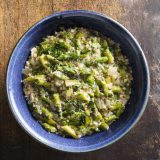In Israel, pearl couscous—the tiny, round pasta shape locally known as ptitim, or “little crumbles” in Hebrew—is a popular pantry staple. But it’s typically thought of as an unsophisticated comfort food—a meal for children. Not so at Tel Aviv’s farm-to-table restaurant Igra Rama.
Here, chef Aner Ben Refael takes the familiar ingredient and does something unexpected: He cooks it like risotto. He first simmers the pearl couscous with butter and white wine until the pasta takes on a thick, rich consistency, then he adds grated pecorino, asparagus and—for a finishing flourish—fresh sage.
Brilliantly simple and satisfying, this dish won us over for its breezier approach to risotto. In contrast to traditional risotto, the pearl couscous requires less hands-on cooking to produce its velvety texture.
The key to its creamy consistency is all about the starch, and it turns out that couscous is uniquely suited to the job when it comes to replacing the more traditional Arborio rice. Pasta releases starch easily in water, but most pastas would turn to mush when given the risotto treatment, absorbing so much water that they gelatinize completely. However, the spherical shape of pearl couscous means that it has a larger proportional surface area than other pastas. Sautéing it along with the aromatics tempers the surface enough to prevent the couscous from becoming mushy. Rather, it retains some of its pleasingly chewy texture while still releasing enough starch to thicken the sauce.
Use the natural starches in beans, lentils, grains and pastas to improve the texture of the finished dish.
Back at Milk Street, we took Ben Refael’s technique and focused on streamlining this already simple dish even further. One surprising discovery emerged in our testing: While most risottos call for chicken or vegetable broth, we found that we didn’t need either. In fact, broth weighed things down; omitting it entirely lightened the dish, while the combination of wine, butter and the couscous’ natural starch provided plenty of richness. And though we liked the delicate vegetal notes of the asparagus, we found it to be an entirely optional ingredient; this couscous risotto needs no embellishment.
The cheese, however, was indispensable. Here, we swapped the pecorino for a milder Parmesan, which melded with the starchy liquid shed by the couscous to form the luxurious consistency we desired. Substituting parsley for the sage added fresh flavor and bright color.




